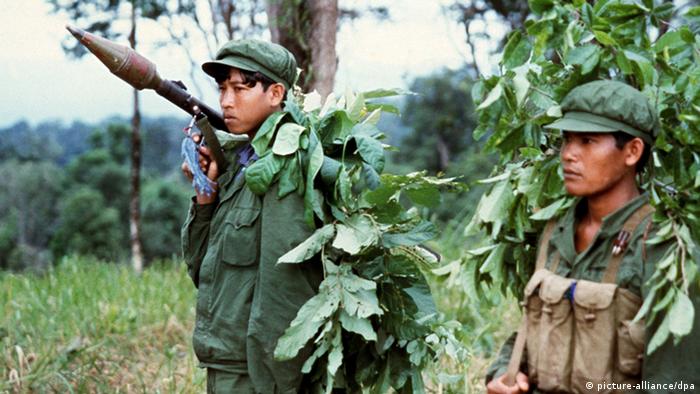The Khmer Rouge is the name that was popularly given to members of the Communist Party of Kampuchea (CPK) and by extension to the regime through which the party ruled Cambodia between 1975 and 1979. Prime Minister Norodom Sihanouk came up with the term in the 1960s to describe his country’s heterogeneous, communist-led dissidents with whom he allied with after his 1970 overthrow.
The army was slowly built up in the jungles of eastern Cambodia during the late 1960s. The Chinese Communist Party, the North Vietnamese army, the Viet Cong, and the Pathet Lao all supported the Khmer Rouge.
Originally, they fought against Sihanouk, on the advice of the Chinese Communist Party. But they changed their position and supported him after he was overthrown in a 1970 coup by Lon Nol.
The Khmer Rouge won the Cambodian Civil war despite the massive American bombing campaign against them. They captured the Cambodian Capital and overthrew the Khmer Republic in 1975.
Following their victory, led by Pol Pot, they renamed the country Democratic Kampuchea in 1976. Their regime was autocratic, totalitarian, xenophobic, and repressive. Their social engineering policies caused many deaths.
![]()
The organization was largely dissolved by the mid-1990s and finally surrendered completely in 1999. In 2014, their leaders were jailed for life by a United Nations-backed court that found them guilty of crimes against humanity.
Pol Pot
Pol Pot was the central figure during the four years that he Khmer Rouge ruled Cambodia. He was responsible for one of the worst mass killings of the 20th century. There is a reason he is among the most evil men in history.
Pol Pot is probably the only man who committed genocide and mass killings against his own citizens. Under his brutal regime, more than two million people lost their lives between 1975 and 1979.
Under the Marxist leader Pol Pot, the organization tried to take Cambodia back to the Middle Ages, forcing millions of people from the cities to work on communal farms in the countryside.
The dramatic attempt at social engineering had a terrible cost.
![]()
Communist Philosophy
The Khmer Rouge traces its origins in the 1960s, as the armed wing of the Communist Party of Kampuchea, the name the Communist used for Cambodia. They were based in remote jungle and mountain areas.
During his time in the remote north-east, Pol Pot was largely influenced by the surrounding hill tribes. They were self-sufficient in their communal living, had no use for money, and were untainted by Buddhism. This is what prompted his ideas for communal leaving.
He hoped and wanted to make Cambodia (Kampuchea) into an agrarian utopia. Pol Pot declared the nation would start again at Year Zero, he isolated his people from the rest of the world and set about emptying the cities, abolishing money, private property, and religion.
People were condemned for wearing glasses or knowing a foreign language.
How were the killings carried out?
We said before that the Khmer Rouge was responsible for more than 2 million killings. Hundreds of thousands of intellectuals, professionals, members of minorities and ordinary citizens were killed in a systematic campaign set to eliminate those deemed to be “impure”.
Many people were held in prisons. There, they were tortured and executed. The most famous prison, S-21, held about 14,000 prisons while in operation.
The End of Khmer Rouge
Pol Pot’s government was finally overthrown in 1979 by invading Vietnamese troops, following a series of violent border confrontations.
The higher echelons of the Khmer Rouge party retreated to remote areas of the country. There, they remained active for a while, but gradually lost their power.
![]()
In the following years, Cambodia began a process of reopening to the international community. Survivors told stories to shocked audiences. Pol Pot was denounced by his former comrades in a show trial in July 1997 and sentenced to house arrest in his jungle home.
In November 2018, international tribunal found leaders of the Rouge guilty of genocide over the attempted extermination of the Chan and Vietnamese minorities. It remains the first and only genocide conviction against the Khmer Rouge.
Facts about the Cambodian Genocide
– Unlike other genocides where specific ethnic groups were targeted for execution, the Cambodian genocide had no exceptions. They singled out doctors, teachers, minorities, people with education, and even babies
– Pol Pot wanted the nation to revert to a self-sufficient way of living where money had no influence in society. Because of this, he forced evacuations of cities into the rural communities for a fresh start
– More than two million people lost their lives. Among them, 100,000 Cham Muslims and 20,000 Vietnamese
– There was no quick international investigation about the genocide because the US lost the Vietnam War and were hesitant to become involved in the region again
– The Hollywood movie The Killing Fields is based off of victims of the genocide first-hand experience. The movie brought attention to what was neglected some few years ago
– In 1997, the Extraordinary Chambers in the Courts of Cambodia was established with the assistance of the United Nations. Its purpose was to judge the senior leaders of the Khmer Rouge for their mass crimes
– Pol Pot faced a show trial in 1997 where he was sentenced to house arrest. He died less than a year later, never facing a real trial for his crimes
– Victims were allowed to actively participate in the trial proceedings
